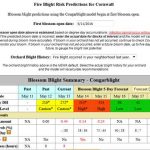Orchards in the Champlain Valley are largely in full bloom now, although Honeycrisp appear to be holding out for a couple of days as usual. I’ve heard reports of good bee flight last Saturday, but cool cloudy weather slowed things the last few days. I did see great bee activity in the UVM orchards this morning though, and the next several days look like good bee days as well, so we should get a decent pollination season out of this. Cooler inland orchards should see bud development pick up with the coming weather, and I expect bloom in Washington and Orange counties to be in full swing by the end of the weekend. Feel free send me reports from your corners of the state.
I’ll get to pest management in a minute, suffice to say that things are a little quiet. Bigger considerations are horticultural: get your fertilizers on, water (especially new trees), and knock down dandelions and other flowering plants in the orchard to concentrate bees in the trees where you want/need them.
Apple scab continues to be quiet. Several sites in the NEWA system were reporting an expected infection period for today, but I’m just not seeing it with the sporadic rain in the forecast and good drying weather. That said, ascospore maturity is very high right now, so any wetting will release a lot of spores with high potential for infection. That assumes that you see rain and subsequent leaf wetness in your orchard. At the temperatures we’re seeing/expecting around the state, you’ll only need 6-7 hours of wetness to trigger an infection period. Sunday looks like our next chance for sustained wetting and significant rain, and even then the chance is not very high (30% listed for most parts of the state). Calm conditions in the next couple of days will facilitate spray applications. Here’s my advice: if you get any significant wetting in the orchard this afternoon and/or tonight, get out tomorrow or soon thereafter with an effective kick-back fungicide, tank-mixed (of course) with a protectant to give some protection against possible infection on Sunday. NO insecticides in this spray- even though some orchards have likely seen a bit of petal fall, I’d take a bet that there is still bee activity (including native bees) in your orchards. If you can hold off for a day or two and have concerns about fire blight because you have susceptible cultivars or had it in the orchard last year, read on.
Conditions for fire blight infection will be increasing as temperatures do over the next couple of days. At this moment, forecast data is not getting pulled into NEWA as I can see it (and a tech support email has been sent), but our own running of the Maryblyt model and my quick NEWA check earlier today suggest high to very high potential for infection if rains come on Sunday. Actual risk in your orchard depends on the same factors I discussed last week: open flowers, a wetting event, warm temperatures, and inoculum present. If you had NO fire blight last year or for several years, this may not be a big issue. But if you have susceptible cultivars and any history of fire blight, this may be one event you want to protect against (assuming you are in bloom). In that case, I would hold off spraying until Saturday, and apply your fungicide along with a full rate of streptomycin with the appropriate surfactant. I would avoid Captan if this is the route you choose to take since phytoxicity may occur when mixed with surfactants. Nothing else in this spray- no growth regulators (Apogee, petal fall thinners), no nutrients, and no insecticides. Petal fall sprays would start next week.
Organic growers should consider applying protective sulfur and avoiding liquid lime sulfur at this stage, since fruit set may be questionable given the early season freeze damage and we’re not sure about what level of thinning may be required. If you have open blossoms and suspect fire blight may be an issue, Serenade and good monitoring may be your best bet. It wouldn’t be bad to start applying Surround to build up a coating for plum curculio season at this point, that can be mixed into this spray and shouldn’t affect pollination.
We’ll talk about petal fall next week after assessing what’s out there to consider thinning. Again, feel free to send me reports from your orchards.
-Terry




